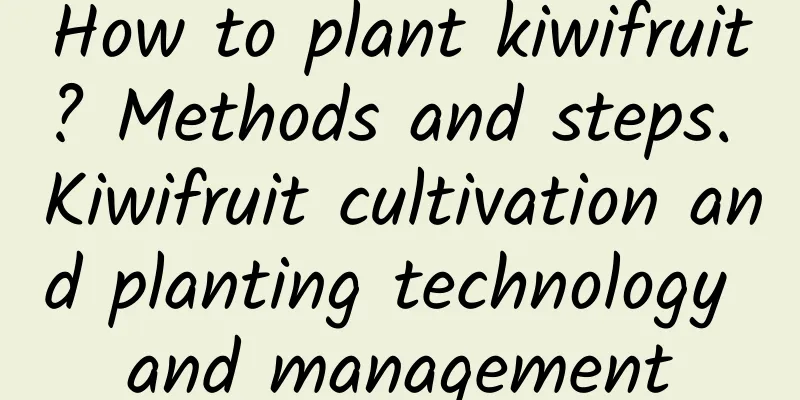How to plant kiwifruit? Methods and steps. Kiwifruit cultivation and planting technology and management

|
Kiwifruit is becoming more and more popular, and the number of farmers planting kiwifruit is gradually increasing. However, if you are not careful in planting, it will affect the quality of the fruit in the later stage. Therefore, you need to understand the growth habits and planting points of kiwifruit in order to grow kiwifruit well. Kiwifruit likes high temperature, is not cold-resistant, and cannot tolerate temperatures below 5°C. It needs plenty of sunlight during its growth period, but is afraid of scorching sun exposure. It likes fertile and loose sandy loam with a pH between 5 and 6.5. It is not suitable to be planted in places with heavy soil and poor drainage. Kiwi fruit planting timeThe southern region is relatively warm, and there is basically no freezing in winter, so kiwifruit can be planted during the rainy season in autumn . In the northern region, kiwifruit seedlings are generally planted during their dormant period , that is, before March in early spring or before kiwifruit buds after leaf fall . Kiwifruit planting steps1. Land preparation and fertilization Land preparation is usually carried out after rain when the soil is loose , and deep plowing is effective at this time. During deep plowing, farmyard manure is applied as base fertilizer , and drainage ditches are dug with a depth and width of about 30 cm and a row spacing of about 3 meters, and the excavated soil is piled in the middle of the ridge. 2. Planting method Because kiwifruit is a dioecious plant, pollination is done by male trees and fruiting is done by female trees. Therefore, when planting, male and female trees need to be evenly dispersed in a ratio of 1:6 or 1:8 , with a plant spacing of about 3 meters and a row spacing of about 4 meters. Kiwifruit cultivation and management methods1. Fertilization and watering The most important thing to pay attention to in kiwifruit planting management is the application of fertilizer. The most commonly used fertilizer is biological organic fertilizer , which has a very good effect of loosening the soil and can also enhance the fertility of the soil. Cow and sheep manure is a good biological organic fertilizer after being fully fermented and decomposed, which is very effective in increasing kiwifruit yields. In the dry season, watering should be done after fertilizing . The first topdressing and watering every year is very important, which can not only increase the fruiting rate of the current year, but also cultivate fruiting branches for the next year. The first fertilization and watering is usually 10 days after the beginning of spring . 2. Pest and disease control Pests and diseases are the nemesis of all crops. Once they are entangled, they will have some impact. Therefore, the prevention and control of pests and diseases is also a key issue in kiwifruit management. Every once in a while, the orchard must be thoroughly cleaned to prevent the breeding of pests and diseases. 3. Branch pruning and fruit thinning Kiwi branches should be pruned when they are young trees. When pruning , in addition to shortening those overly long branches , the thin branches should also be removed to save some nutrients for healthy branches to thrive. In mid-May, start removing sprouts, pinching, thinning and tying fruit trees , removing the sprouts on the branches to prevent the branches from growing too densely. Fruit thinning starts 2 weeks after flowering , keeping normal fruits with strong stalks and good growth, and removing diseased, small, deformed and overcrowded fruits . Keep 4 to 5 fruits on each branch, and only 2 on weak branches. |
<<: Peony planting per mu yield and profit Peony planting technology and per mu yield
>>: What is the best season to plant ginkgo trees? What is the best month to plant ginkgo trees?
Recommend
What is inorganic fertilizer?
Introduction to Inorganic Fertilizer Inorganic fe...
Black bean germination process
Black bean germination process Generally, when cu...
A complete list of Feng Shui taboos for growing flowers indoors! Don't watch it, you'll suffer a great loss
1. Feng Shui taboos for growing flowers in the be...
What fertilizer to use for rubber trees
Fertilizing rubber trees is very simple. You only...
Can gardenia be transplanted in autumn? Can it survive if transplanted in autumn?
Can gardenia be transplanted in autumn? Gardenia ...
How does outdoor celery in the north survive the winter?
The best time to plant celery in the north is spr...
To plant succulent plants in pots, just rely on this 10-word mantra and they will grow quickly and fill the pots!
Remember this 10-word formula, and you will get a...
The growing environment and local conditions of pine trees
Pine Tree Growth Environment and Conditions Pine ...
How to dwarf potted honeysuckle
Controlling water and fertilizer for dwarfing hon...
List of 9 common poisonous flowers in home gardening
Poinsettia Poinsettia stems and leaves release to...
Common types of flower diseases
Common types of flower diseases Plant disease typ...
How often should I water the crabapple? Does it need to be watered every day?
How often should you water the crabapple flowers?...
What fertilizer to use for hydroponic white palm
1. What fertilizer to use Anthurium can be grown ...
What should I do if the roots of a large pot of green radish are rotten? Do I need to water it after the rotten roots are potted?
1. What to do if the roots rot 1. Turn the plant ...
What are green vegetables
1. Lettuce The leaves of lettuce are long lanceol...









